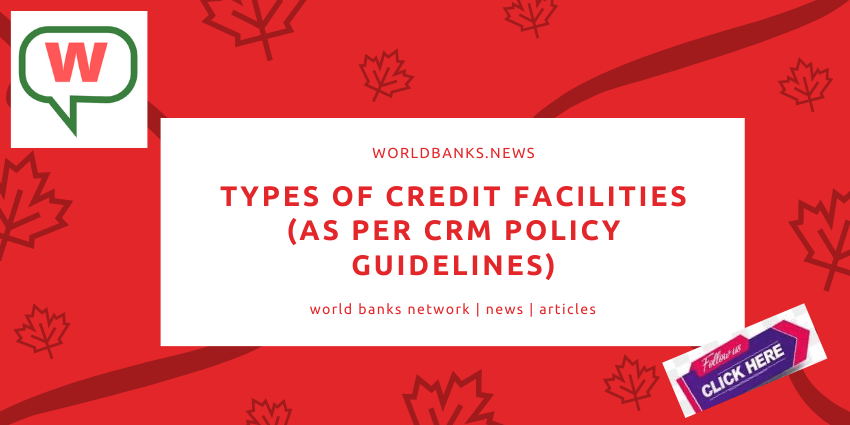Types of credit facilities (As per CRM Policy Guidelines)
- Term financing for new project and BMRE of existing projects (Large, Medium, SE)
- Working capital for industries, trading, services and others (Large, Medium, SE)
- Import and Export Finance
- Lease Finance
- Consumer Finance
- Fee business
- Islamic mode of finance
What is Loan, Advance & Credit ?
Loans, Advances and Credit are interchangeably used without making any distinction. To a commoner it matters very little whether it is called Loans or Advance or Credit as long as these are money lent out to the people.
What is Lending Caps ?
Lending Caps is pre-measures against one sided loan and diversify the total loan in various sectors instead of one sector to minimize the total risk and to maximize the future growth of the Bank. As per CRM Policy Guidelines, every Bank has established a specific industry-wise lending caps considering the existing concentration and future growth of opportunities.
All loans and advances 4 categories :
01. Continuous
Loans and advances without fixed repayment schedule but having an expiry date and a limit are called continuous loan such as CC, OD etc.
0
2. Demand
Demand loans are those loans which are repayable on demand such PAD, LIM, FBP.
03. Fixed Term Loan :
Loans which are payable within a fixed repayment schedule are called Term Loan.
For example, House Building, Transport Loan.
04. Short Term Agricultural Loans :
Short term micro credit will include any micro credits not exceeding Tk.25,000/- and repayable within 12 months are also treated as short term loan.
Loan Period :
- Short Term – Period is over 18 months.
- Medium Term Loans – Period is over 18 months and upto 5 years.
- Long Term Loans – Period is over 5 years.
Loans :
When an advance is made in a lump sum repayable in fixed monthly instalment is called a loan.
Overdraft :
Temporary financial accommodation with a certain limit granted in customer’s SOD A/c. Interest calculated on daily product basis.
Cash Credit :
Financial accommodation in a separate account with a certain limit and validity, secured by pledge or hypothecation of goods.
Clean Loan/Unsecured Loan :
Loan which is granted to a borrower without obtaining any security from him is called Clean Overdraft or Clean Loan.
What is Working Capital :
The capital left to work within running the company’s day to day business i.e. the left over from a company’s paid up capital and reserves after all its fixed assets have been bought.
Micro-Credit :
Refers to small credit specially credit for the poor, agriculture, rural development and other types of credit for poverty alleviation. NGOs in our country are engaged in financing micro-credit needs of the rural areas.
Consortium Advance:
Consortium loan means joint finance by more than one bank to the same party against a common security. The entire security remains charged to all these banks for the total advances. All the consortium banks have a Pari Passu charge on the security.
Causes of Sickness :
- Mismanagement or inefficient management.
- Faulty project planning and site selection
- Inappropriate financial structure
- Inefficient working capital management and financial budgeting
- Absence of costing and pricing
- Inefficient system of record keeping
- Diversion of funds
- Inappropriate plant and machinery and inadequate maintenance
- Lack of quality control
- Lack of forecasting
- Lack of emphasis on research and development
- Absence of product planning and market research
Features of Good Securities :
- Good title and easy transferability
- Marketability
- Ascertainable value
- Stability of value
- Worth storing
- Low maintenance cost
- Perishability
- Free from liability
What is Charge ?
Charge means right of payment out of certain property. In a charge, there is no transfer of interest or property. It is a right over some tangible assets of the borrower.
Why Charging Securities :
Charging securities means creation of charge over the securities against which loans and advances are granted. Sometimes, money borrows may fail to repay the bank money (dues) for various reason. To face the situation, bank’s obtained securities.
Kinds of Charge :
(a) Fixed Charge & (b) Floating Charge.
Fixed Charge :
When a charge created against land, building and heavy machinery is called a fixed charge.
Floating Charge :
When a charge created against stock in process, raw materials etc. is called a floating charge.
Pari Passu Charge :
Pari Passu is a Latin word. When several lenders (consortium lending) create charge on a common security of a single borrower on the basis of an agreed ratio, it is called Pari Passu charge.
Collateral Security :
Security in addition to primary security as a guarantee of loan is called collateral security. Mostly these are mortgages of immovable properties.
Mode of Charging over securities :
- Lien
- Hypothecation
- Pledge
- Mortgage
- Assignment
- Set-Off
Lien : (Contract Act)
Lien is the right of the creditor to retain the goods and securities in his possession, belonging to a debtor, until the debt due is paid.
Particular Lien :
Particular lien relates to only the subject goods against which advances have been sanctioned.
General Lien :
A general lien entitles a person to retain possession of goods belonging to another for a general balance of account.
Banker’s lien more than a general lien :
As a general rule, the right of lien does not give the person to exercising the right, any power or right to sell or dispose off the securities retained. But in case of a Bank, it otherwise, a Banker’s lien is more than a general lien.
Negative Lien :
In this case bank’s take a declaration from the borrower that the assets mentioned therein will be free from any sort of charge.
Hypothecation :
The mortgage of movable property is called hypothecation. Charge against property for an amount of debt where neither ownership nor possession is passed to the creditor.
Pledge : (Contract Act)
A bailment of goods as security for payment of a debt or performance of a promise.
Difference between Pledge and Hypothecation :
| Pledge | Hypothecation |
| Pledge created only floating assets Possession of the goods held at Bank. It is easy for the bank to dispose off the goods because goods are held at Bank. For any damage bank will be liable. For auction of goods, court order required. | Hypothecation created on fixed/floating assets.Possession of the goods held at the party. It is not easy for the bank to dispose off the goods because goods are held at party. For any damage party will be liable. For auction sale of goods, court order is not required. |
Mortgage : (Transfer of Property Act).
When immovable property like land, building, heavy machinery is offered by a customer as a security for loan, a charge thereon is created by means of a ‘Mortgage’. Mortgage is charging in case of immovable property.
7 kinds of Mortgage i.e. (01) Simple mortgage, (02) Mortgage by conditional sale (03) Usufructuary mortgage (04) English mortgage (05) Mortgage by deposit of Title Deed (06) Anomalous mortgage (07) Legal mortgage.
Legal Mortgage :
The mortgagor transfers to the mortgagee the legal title to the property. It must be registered. On repayment of the loan, the mortgagee transfer the title to the mortgagor.
Equitable Mortgage :
The mortgagor deposits the title deeds with the mortgagee with the intention of giving the mortgagee an equitable interest in the property. It does not require registrations.
Second Mortgage:
If the mortgaged property of the mortgagor is mortgaged again to another person as security for further borrowing, such a mortgage is called second mortgage.
Assignment : (Transfer of Property Act – 1882)
An assignment means transfer of an existing or future right, property or debt by one person to another person.
Banker’s Right of Set-Off.
A banker has the right to set-off. This right entitles him to adjust a debit balance in some account of a customer against any credit balance in his other account(s). Accounts of a customer can be combined/set-off subject to the following conditions, namely (a) If the different accounts are held by the same parties in the same right, debit balance in his own account can not be adjusted with the credit balance of trust account in his own name (b) The debt must have become actually due. The right can not be exercised against further or contingent debt and (c) There is no express or implied agreement to the contrary.
Banker’s Right of Automatic Set-Off.
A banker has the automatic right of set-off in the following circumstances
- On death, insanity or insolvency of the customer
- On the insolvency of partner of a firm or on the winding up of a company.
- On receipt of a Garnishee Order. The banker on receipt of a garnishee order can exercise the right of set-off and surrender only the surplus to the judgement creditor
- On receiving notice of assignment of a customer’s credit balance and
- On receiving notice of second mortgage over the security charged to the bank.
5 Cs : The Integrity and reliability of the borrower :
01. Character – Character denotes the integrity of the borrower.
- Capacity – Capacity means the ability to employ the funds profitably and repay the loan.
- Capital – Capital denotes financial soundness.
- Collateral
- Condition
Advantages of proper Documentation:
- Procures a written evidence of transactions.
- Identifies the borrower, co-borrower and guarantors
- Identifies the securities
- Identifies the nature of charges created by the bank.
- Include protective clauses to safeguard the interest of the bank.
- Accepted as an evidence in the court of law.
- Complies the requirement of Bangladesh Bank and other instructions/regulations etc. of individual bank for better Management of advances.
- Certain documents give a right to file a summary suit.
Power of Attorney:
A ‘power of attorney’ is an instrument whereby one person empower another person to act for and in the name of the person giving such powers.
Fixed Assets:
Fixed asset are land, building, plant and machinery, furniture and fixtures, tools, transports like motor car, van, cycle, tempo etc.
Banker, should, therefore, examine the following points while analysing the fixed assets.
- How the fixed assets are valued in the balance sheet
- What is their current market value
- What is their forced sale value if put to auction
- Date of purchase in relation to valuation and cost price according to current price level.
- Whether sufficient deprecation has been provided or sufficient reserve has been created for the purpose.
Intangible Assets:
Intangible assets, also called fictitious assets, do not represent any material asset or property. They are represented by either deferred revenue expenditure or expenditure which for the sake of prudence should not be taken to carry any value. They also include items, such as, goodwill, patents, trade marks, designs. Preliminary expenses, debit balance of profit and loss account, discount on shares or debentures etc. Intangible assets are non-physical and intangible in nature but have quite a long period of usefulness to the business.
Net Worth:
Capital + Paid in Surplus + Retained Earnings = Net worth
What is net worth:
The net worth of a business is calculated by subtracting the current liabilities from the total assets after deducting fictitious assets.
Definition of Capital :
Capital will be considered in two tiers : (a) Tier-I (Core Capital) and (b) Tier-II (Supplementary Capital). Tier-I capital will comprise the highest quality capital elements and Tier-II capital will represent other capital elements which fall short of some of the characteristics of core capital but which contribute to the overall strength of a bank.
Core Capital (Tier-I)
01. Paid-up Capital
02. Statutory Reserve
04. General Reserve
05. Retained Earnings
Supplementary Capital (Tier-II)
- General Provision (1% of unclassified loans)
- Assets Revaluation
- All other Preference Shares
- Perpetual Subordinated Debt
Minimum Capital Standards :
Each bank is required to maintain a ratio of capital to risk weighted assets of non less than 10% with at least 4.5% in Core Capital. However, the minimum capital requirement of Tk.1000 Million for both the locally incorporated banks and banks incorporated outside Bangladesh will remain unchanged.
Window Dressing :
Window dressing means manipulation of accounts to conceal vital facts and present the financial statements in a way to show a better position than what it actually is. On account of such a situation, presence of a particular ratio may not be a definite indicator of good or bad management.
Guarantee :
A contract of guarantee is a contract to perform the promise or discharge the liability of a third person in case of his default.
A guarantee has three parties : The Surety, The Debtor and the Creditor.
Indemnity :
A contract of indemnity is a contract by which one party promise to save the other (beneficiary) from loss caused to him by the conduct of the promisor (indemnifier) himself or by the conduct of any person.
What is Merchant Bank :
Merchant Bank is a traditional term for an Investment Bank. Merchant Banks work as a financial intermediary, offering such services as takeover, merger, acquisition advice/assistance, financial restructurings & associated finance (raising necessary funds), equity investments in companies and the placing of new share and bond issues, but do not offer usual banking services to the general public.
A full fledged merchant bank provides diversified services for the capital market to investors. The offered services are :
- Portfolio Management.
- Issue Management.
- Underwriting.
- Corporate Advisory
- Banker to the Issue
Leasing :
Leasing, in general, is viewed as a method of financing the acquisition of capital equipments. In view of the nature of technology involved, pace of innovations and change and customs of the trade and business, lease contracts are structured to suit the convenience of borrowers or lessees.
OFF-Shore Banking :
Off-shore banking refers to the international banking business involving non-resident foreign currency denominated assets and liabilities. It refers to the banking operations that cover only non-residents and do not mix with domestic banking.
Import Finance : LIM, PAD
Export Finance : L/C
LOAN CLASSIFICATION AND PROVISIONING :
Basis for Loan Classification :
- Objection Criteria
- Qualitative Judgement
All good loans are treated as Unclassified and Overdue loans have been classified into 4 categories
- Special Mention (SM) Account
- Sub-Standard (SS)
- Doubtful (DF)
- Bad & Loss (BL).
Objective criteria for determining the preliminary classification status is as under :
Period of Arrears Classification Status
a) Less than 3 months UC
b) 3 – 6 months SM
c) 6 – 9 months SS
d) 9 – 12 months DF
e) 1 year and above BL
Provision for Classified Loans :
01. General Provision in all Loans – 1%
02. Sub-Standard – 20%
03. Doubtful – 50%
04. Bad & Loss – 100%
Reschedulement : Down Payment requirement
Term Loan :
1st time reschedulement = 15% of the overdue instalment or 10% of the total outstanding
whichever is lower.
2nd time reschedulement= 30% of the overdue instalment or 20% of the total outstanding
whichever is lower.
3rd time or more reschedulement = 50% of the overdue instalment or 30% of the total
outstanding whichever is lower.
Five core risks:
- Credit Risk.
- Asset Liabilities Risk.
- Foreign Exchange Risk.
- Internal Control & Compliance Risk.
- Money Laundering Risk.
What is Credit Risk : Loan given to borrower but non payment of loan is credit risk.
What is CRM?
CRM means Credit Risk Management. It is a dynamic process which enables banks to proactively manage loan portfolios. It has four major areas:
01. Policy – Lending guidelines
02. Procedure – Evaluating viability
03. Organizational Structure – Segregation of risk taking and risk approving authority
04. Responsibility – Decision making and accountability
How No. of Risk in Credit Risk ?
01. Financial Risk – 50%
02. Business/Industrial Risk – 18%
03. Management Risk – 12%
04. Security Risk – 10%
05. Relationship Risk – 10%
100%
CRM Policy objectives.
1) Maximizes bank’s earning from loan portfolios.
2) Improve quality of loan
a) To keep NPL below 10%
b) Arresting new loans to become CL
3) Utmost emphasis on loan sanctioning
4) Evaluate credit Risks
5) Monitor continuously
6) Price the loans
7) Strict adherence to Bangladesh Bank guidelines.
Single Borrower/Groups Limits :
(a) Single person or enterprise or organization of a group –
Non-funded 35% of total bank’s capital – Funded 15% of total capital
(b) Export sector single borrower- 50% non funded of bank capital – 15% funded of bank’s capital
Large Loan :
Loan sanction to any individual or enterprise or any organization of a group amounting to 10% or more of bank’s total capital shall be considered as large loan.
Lending Caps :
Concentration in a single industry is not prudent. Diversification is necessary for spreading risk and taking advantage of opportunities. Considering bank’s existing concentration and future growth opportunities, industry wise lending caps are suggested to balance and optimize its credit portfolio.
Discouraged Business Types:
- Military equipment/weapon finance
- Highly leveraged transactions
- Finance of speculative business
- Logging, mineral extraction
- Black listed CIB
- Counter parties in countries subject to UN sanctions
- Share Lending
- Taking an equity stake in borrower
- Lending to holding companies
- Bridge loans
Insurance – Risk to be covered :
01. For goods in trade : Flood, Cyclone, Norwester, Fire, RSD
02. For Machinery : Fire, RSD, MBD, Flood, Cyclone, Norwester.
03. For imported : All risks including WAR & SRCC and Non-Delivery.
RISK GRADING :
The facilities of Tk.50.00 lac and above shall be assigned a Risk Grade.
Risk Grading Score Card :
| Number | Risk Grading | Short Name | Aggregate Score |
| 1 | Superior – Low risk | SUP | 100% |
| 2 | Good – satisfactory risk | GD | 85+ |
| 3 | Acceptable – fair risk | ACCPT | 75-84 |
| 4 | Marginal/Watchlist | MG/WL | 65-74 |
| 5 | Special Mention | SM | 55-64 |
| 6 | Sub-standard | SS | 45-54 |
| 7 | Doubtful | DF | 35-44 |
| 8 | Bad & Loss | BL | <35 |
CREDIT RISK GRADING
01. Financial Risk – 50%
02. Business/Industrial Risk – 18%
03. Management Risk – 12%
04. Security Risk – 10%
05. Relationship Risk – 10%
Islamic mode of Banks – Deposit mobilization through operation of the following accounts.
- Al-Wadeeah Current Account
- Mudaraba Savings Account
- Mudaraba Term Deposit Account – 3, 6, 9, 12, 24 months to 36 months
- Mudaraba Special Notice Account
- Mudaraba Hajj Savings Account
- Mudaraba Special Savings (Pension Scheme) 5 to 10 years scheme
- Mudaraba Savings Bond Scheme.
- Mudaraba Monthly Profit Deposit Scheme
- Mudaraba Foreign Currency Deposit Account
Different types of Investment Account :
- Mudaraba (The hiring of capital)
- Musharaka (partnership profit sharing)
03. Bai-Murabaha (Contract sale)
04. Hire Purchase under Shirkatul Meelk
05. Bai-Muajjal (Sales under deferred payment)
06. Bai-Salam (Advance Sale & Purchase)
07. Bai-Istisna
08.Quard-E-Hasana (Benevolent Loan):
09. Ijarah -Leasing




















